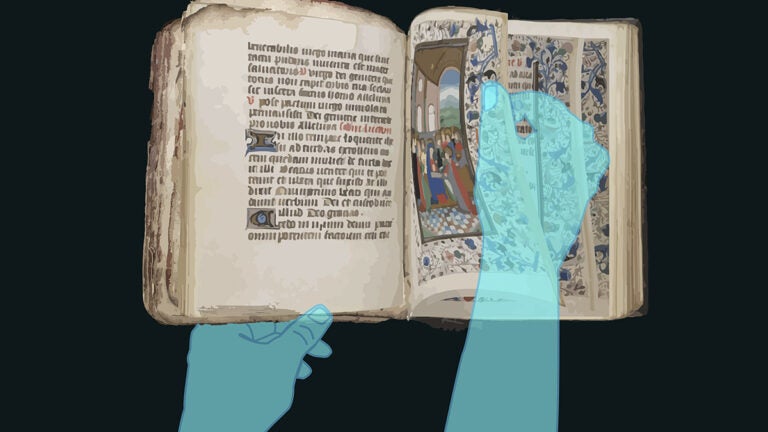
Virtual reality takes users back to a 15th-century community of religious women
When you first pick up the 15th-century book of hours, it may feel heavy. The pages are delicate, but the illuminated scenes are far more vibrant and meticulous than anything in a coffee table book. Looking up, you find yourself in a small, spare, sunlit room, or maybe a dim stone chapel. You may be surrounded by background voices or standing in complete silence.
The opportunity to handle a Renaissance-era manuscript and visually explore the world in which it was originally used is one most people rarely get. But a new project by two scholars at the USC Dornsife College of Letters, Arts and Sciences is using virtual reality technology to give users the chance to not only hold and page through such a book, but also to look up and see a digital recreation of the room in which its 16th-century owner might have used it, along with information on the context and daily experience of that owner at the beguinage — a community of religious laywomen — where she lived.
“I think technology can help to reach a wider public and to engage people who don’t know much about these manuscripts. It can invite them to explore them in a way that may be more intriguing and appealing,” said Sabina Zonno, visiting postdoctoral scholar at the USC-Huntington Early Modern Studies Institute and co-leader of the project. The project received a $50,000 grant this past summer from the National Endowment for the Humanities’ Office of Digital Humanities.

Lynn Dodd. (Photo: Peter Zhaoyu Zhou.)
Lynn Dodd, associate professor of the practice of religion and spatial sciences, co-leads the project with Zonno. Dodd added that the connection between object and space is important. “What our project intends to do is reconnect the manuscript and its images, which are hand-painted into that book, to the place where it was originally read.”
Who owned the book?
The origins of the project can be traced back to USC Libraries Special Collections, where Zonno, who is an expert in illuminated manuscripts, unearthed the work from a box. She saw that it was a book of hours, an illuminated devotional book that contained prayers and other spiritual texts and was often used by laypeople for private or church-based worship. This particular manuscript was especially interesting, Zonno said, because its owner wrote her name and where she lived — Saint-Elisabeth Beguinage in Ghent, Belgium — at the end of the manuscript.
Beguinages, which date back to the Middle Ages, were usually communities of religious laywomen who lived together but did not take vows, as nuns did. There was usually a church on the premises, along with a prioress to lead the mass. Even beguines who were illiterate often used books of hours and other spiritual texts as guideposts in their personal devotion.
“In the case of these prayer books, the women knew these prayers by heart, especially in these communities because they went to church often. If she couldn’t read, the illuminations helped keep her on track of where she was in the text,” Zonno said. “I imagine her holding the book and either reading or looking at the images and praying.”
It was common, Zonno said, for women at a beguinage to bequeath their books to members of the same community, which is probably how the woman who wrote her name in the book came to possess it.
“I think she inherited the book. There is a gap between when the manuscript was illuminated — 1450 to 1460 — and when the note was added, which I think was at the beginning of the 16th century,” Zonno said.
Creating a world for the manuscript
To create a virtual reality for the manuscript and its context, Zonno and Dodd, along with Eric Hanson, associate professor of cinematic practice at the USC School of Cinematic Arts, will first take thousands of still photography images of the manuscript and beguinage, the latter of which still exists. Those photos will be used to build three-dimensional models, which are then brought to a game engine unit (a framework used by developers to construct video games), which renders them so they are ready to use in a virtual reality headset, Hanson said. He added that virtual reality gives an experience far deeper than that of film.
“It allows the viewer to have a very strong sense of presence. As you shift your weight on your feet, you’ll get different senses of perspective. There’s an astonishing sense of heightened awareness,” Hanson said.
Dodd added that the most innovative aspect of the VR experience is the feedback it gives. For example, a user quickly flipping through the virtual manuscript might get a notice that in real life their movements would tear or damage the pages of the physical book. The real book was cherished and valued by its owner, Dodd said. She pointed out that by learning to handle rare or fragile things in the same way, not only can users more wholly put themselves in the place of the book’s original owner, but they also gain skills to help them preserve such items so that they last several more centuries.
Dodd said that in addition to connecting people with the past, virtual reality can help bring them together in the present. A virtual recreation of a prayer session at a mosque, for example, could show translations of the prayers and songs involved, and let users watch adults and children in their everyday interactions within the building. Such an experience might help “demystify” Islam and counter Islamophobia, she added.
At a time when the world and its people seem more fractured than ever, virtual reality could present a way to connect us not only with the past, but with each other in the present, to create a better future.